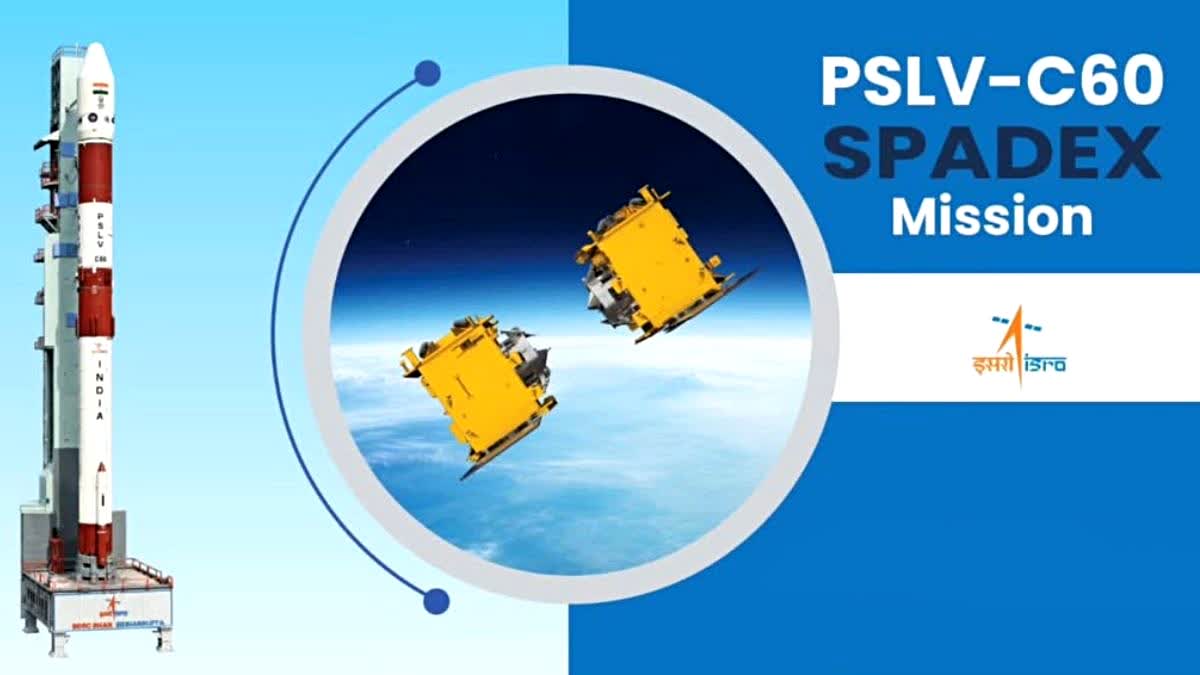New Delhi: India stands on the cusp of a major milestone in its space exploration journey, as the Indian Space Research Organisation (ISRO) prepares to launch the Space Docking Experiment (SpaDeX) tonight at 10:00 PM IST. The highly anticipated mission will lift off from the Satish Dhawan Space Centre in Sriharikota aboard the PSLV-C60 rocket, marking a significant leap in the nation’s space capabilities.
The mission was earlier scheduled for 9:58 PM and now has been delayed by two minutes due to space congestion. It will now lift off at 10:00 PM tonight.
The SpaDeX mission will demonstrate the autonomous docking and undocking of two satellites in orbit, a critical technology for future space exploration endeavours such as the development of an Indian space station, human lunar missions, and advanced interplanetary projects.
What Is SpaDeX?
SpaDeX, or Space Docking Experiment, aims to showcase India’s technological prowess by autonomously docking two satellites in low Earth orbit. Docking is the process by which one spacecraft attaches itself to another while undocking involves their separation. These capabilities are essential for resource transfer, in-orbit refuelling, spacecraft modular assembly, and long-duration space missions.
The mission involves two small satellites, SDX01 (Chaser) and SDX02 (Target), each weighing approximately 220 kilograms. The satellites will be placed in a circular orbit at an altitude of 470 kilometres above Earth. Using cutting-edge sensors and algorithms, they will locate, align, and dock with each other, achieving a milestone that only a handful of nations have accomplished.
Expert Insights on SpaDeX
Former ISRO scientist Surendra Pal told ETV Bharat about the mission as a defining moment in Indian space history. “December 30, 2024, will be a golden day in the Indian Space Program,” he said. “We are ending 2024 with a groundbreaking event and entering 2025 with immense hope. This mission is the first time the entire satellite system has been assembled by the industry, showcasing a crucial collaboration between ISRO and private players."
“The mission will test multiple innovative technologies, such as optical and laser sensors, autonomous systems, and in-orbit servicing. Once the Chaser and Target satellites are launched, they will initially remain 10–15 kilometres apart and then gradually reduce this distance through precise manoeuvers. By conducting this experiment, India will join the ranks of NASA, Russia, China, and the European Space Agency as a nation capable of autonomous docking. All these technologies have been developed indigenously, without external assistance—a testament to India’s growing expertise in space innovation,” he added.
Manish Purohit, another former ISRO scientist, elaborated on the mission’s significance and technical complexities: “SpaDeX is critical for ISRO’s ambitious goals, including placing astronauts in space, establishing a space station, and conducting future lunar exploration missions like Chandrayaan-4. Autonomous docking is a cornerstone for these efforts, as it enables modular assembly, resource sharing, and sample transfers between spacecraft."
“The process involves three phases: rendezvous, soft capture, and hard capture. In the rendezvous phase, the Chaser locates and aligns with the Target using advanced sensors like laser rangefinders and LED arrays. Once aligned, the soft capture phase begins, during which the Chaser makes a low-impact connection with the Target at millimeter-per-second velocities. This ensures minimal force during initial contact. Finally, in the hard capture phase, the two spacecraft firmly latch together, forming a single unit with integrated systems for power and communication. Notably, ISRO has patented its innovative design for this hard-latching mechanism, which will be tested during this mission,” Purohit added.
Mission Highlights
• Satellites: Two satellites, SDX01 (Chaser) and SDX02 (Target), each weighing approximately 220 kilograms.
• Orbit: Circular orbit at 470 kilometres above Earth.
• Payloads: Includes 24 experimental payloads on the PSLV Orbital Experimental Module-4 (POEM-4) platform.
• Objectives: Demonstrate autonomous docking, validate energy transfer between docked spacecraft, and assess post-undocking payload performance.
• Challenges: Achieving precise alignment and coordination for docking at speeds of 28,800 km/h.
How SpaDeX Works
The two satellites will initially be placed 20 kilometres apart in the same orbit. Through a series of carefully controlled manoeuvres, they will reduce this distance step by step, closing the gap to execute a far rendezvous. Once aligned, the Chaser will dock with the Target autonomously, completing the mission’s primary objective.
In addition to docking and undocking, the mission will validate critical capabilities such as energy transfer between docked spacecraft, which is vital for resource-sharing in long-duration missions. These tests will also provide valuable data for future interplanetary missions and human spaceflight programs like Gaganyaan.
Significance of SpaDeX
